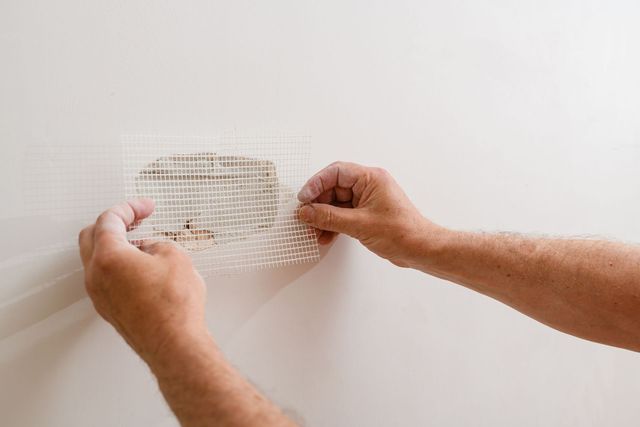Step-by-Step Approaches to Achieving Flawless Drywall Repair Service and Setup
Achieving flawless drywall repair service and installment calls for a systematic approach. It includes understanding the different sorts of drywall and the devices necessary for the job. Appropriate area prep work is vital before beginning any kind of job. Interior Painting. Each action, from patching openings to installing brand-new sheets, demands focus to detail. The process does not finish with installment; ending up techniques are vital for a refined look. The next steps will assure a seamless outcome, however exactly what do they involve?
Comprehending Drywall Types and Equipment Needed

The installation tools are just as vital. An energy blade is important for cutting drywall sheets, while a drywall saw can assist in making accurate cuts for components or outlets. T-squares guarantee accurate dimensions, and drywall screws or nails protect the panels to wall surface studs. Furthermore, a drywall lift can facilitate the setup of huge sheets, reducing physical stress. Experience with these tools and kinds considerably adds to the performance and top quality of drywall jobs.
Preparing the Area for Repair Work or Installation
Preparing the location for drywall repair service or installation is vital to assure a reliable and smooth process. First, the surrounding space ought to be free from furnishings and various other barriers to provide sufficient functioning area. This not only assures safety and security but likewise prevents damages to personal belongings. Next off, it is vital to cover the flooring with ground cloth to catch any particles or dust created during the work.
In addition, the wall surfaces should be inspected for any kind of loose paint or wallpaper that might disrupt adhesion. Removing these components creates a clean surface area for the brand-new drywall. Before beginning, it is advisable to turn off power to electric outlets or components around. Making certain ample illumination in the office will certainly further enhance presence and emphasis during the repair work or installation procedure. drywall contractor. By thoroughly preparing the location, one prepares for an effective drywall project
Step-by-Step Refine for Patching Holes

Patching holes in drywall needs a methodical method to guarantee a seamless fixing. The very first action entails examining the size of the opening. For small openings, a patching substance may be enough, while larger holes demand a spot. Next off, the broken area needs to be cleansed and prepared by removing any type of loose debris.
For little holes, using spackling substance with a putty knife is suggested, smoothing it over the hole and feathering the sides. As soon as dry, fining sand the location ensures a smooth coating. For larger holes, a drywall patch ought to be reduced to dimension, positioned over the opening, and secured with screws. After setting up the spot, the same spackling process is duplicated, complied with by sanding.
Ultimately, the patched area has to be primed and repainted to match the bordering wall. This careful process ensures a specialist appearance and expands the lifespan of the repair.
Mounting New Drywall Sheets: A Comprehensive Guide
Installing new drywall sheets needs cautious planning and execution to guarantee a sturdy and aesthetically appealing surface. The area has to be determined accurately to establish the number of sheets required. It is important to choose the best thickness, normally 1/2-inch for interior wall surfaces and 5/8-inch for ceilings or fire-rated applications.
Next, the studs or framework should be checked for any kind of irregularities, making certain they are straightened and properly spaced. When placing the drywall sheets, they should be positioned horizontally to reduce seams and enhance structural integrity. A drywall lift can be useful for overhead installations.
Fastening the sheets with drywall screws at proper intervals makes sure a protected installment. It's crucial to countersink the screws a little listed below the surface to plan for the completing procedure. Adhering to these guidelines will certainly result in a solid foundation, prepared for the next action in drywall ending up.
Finishing Touches: Insulation, Mudding, and Fining Sand Methods
As soon as the drywall sheets are safely secured, the focus moves to the finishing touches that will certainly give a sleek look. more info This procedure begins with taping, utilizing either paper or fiberglass fit together tape to cover the seams between sheets. The tape guarantees a smooth change, lowering the danger of fracturing. Following taping, mudding is vital; a joint substance is used over the tape to load voids and create a smooth surface area. Usually, multiple layers are required, every one feathery out better than the before lessen visibility.
After enough drying out time, sanding is the last step in attaining a remarkable surface. A fine-grit sandpaper is made use of to smooth the dried out compound, assuring there are no blemishes or bumps. Focus to detail during this phase is significant, as it considerably affects the overall appearance of the wall. The end outcome should be an even, professional-looking surface all set for priming and painting.
Regularly Asked Questions
Exactly how Do I Select the Right Drywall Thickness for My Job?
To pick the right drywall thickness, consider the job's function, area, and structural demands. Standard thicknesses include 1/2-inch for general use and 5/8-inch for fire-rated applications, making sure resilience and conformity with building codes.

Can I Mount Drywall Over Existing Drywall?
Yes, setting up drywall over existing drywall is possible. It is important to guarantee the underlying surface area is secure and totally free from damages. Proper fastening and consideration of thickness are essential for a successful setup.
What Are the most effective Practices for Drywall Disposal?
The finest methods for drywall disposal consist of recycling when feasible, utilizing local waste monitoring solutions, and following guidelines for unsafe materials if relevant. Drywall Repair Ogden UT. Correctly labeling and sealing waste assurances conformity and safety and security during disposal
Just how Lengthy Should I Await Mud to Dry Before Sanding?
Generally, one ought to wait 24 hours for drywall mud to completely dry before fining sand. However, drying time can differ based upon humidity and temperature, so looking for a company structure is a good idea before continuing.
Exist Eco-Friendly Drywall Options Available?
Yes, environmentally friendly drywall alternatives are available. These options typically utilize recycled materials, low-VOC adhesives, and lasting manufacturing methods, lowering ecological impact while giving reliable insulation and longevity for numerous construction and improvement projects.
An utility blade is essential for reducing drywall sheets, while a drywall saw can assist in making accurate cuts for electrical outlets or components. Preparing the location for drywall fixing or installation is crucial to assure a smooth and effective process. Patching holes in drywall requires a systematic technique to ensure a smooth fixing. Setting up new drywall sheets requires mindful preparation and execution to assure a aesthetically appealing and sturdy finish. Yes, mounting drywall over existing drywall is possible.